 Meteorite Classification Page
Meteorite Classification Page Meteorite Classification Page
Meteorite Classification Page
| ASU-NWA-1 | GC_1 | GC_2 | GC_3 | GC_4 | NWA 5799 |
Classification: ASU-NWA-1, Coord. Unknown, L--, LL-- (unpublished data)
Methods: sample description, sectioning (thin section sample and mirrored chip sample for SEM) and preparation
Analyses: Chemical anaylsis using ESEM/EDX in Appalachian State University College of Arts and Sciences Electron Microscopy Lab
Acknowledgements: Jim Rice (for specimen donation), Steve Hageman (Director of CAS SEM facility), Rick Abbott (for direction and techincal expertise)
Sample Selection:
An unclassified sample was selected randomly from a bag of unclassified NWA (North West Africa) meteorites purchased at the Tucson Gem and Mineral Show. It was visually identified for common surface characteristics such as regmaglympts, chondrules, metallic splotches, relict fusion crust. It was photographed before specimen preparation. The sample has been given the provisional name Appalachian State Univeristy- Northwest Africa- 1 (ASU-NWA-1).
The specimens were given provisioonal names (ASU-NWA) until the completion of the project. At the comletion of a classification they will be compared to known smeteorites of similar lithology and either classified as being paried individuals or newly classified individuals.
Sample Description: ASU-NWA 1
ASU-NWA-1 has a reddish-brown weathered surface showing some chondrules and oxidized metal. One fracture appears on the sample.
Surface Morphology- Sample has two distinct textures, a smoothed side (ablated) and a roughened weathered side. The sample has been sculpted during flight. A nose point of sorts is visible and indicate either melting upon breakup, or orientation during flight. No regmaglympts or flow lines were visible on the surface. The sample may have a minor amount of original fusion crust.
  |
ASU-NWA-1 photographed before and after cutting. |
Internal characteristics- Texture- chondritic with metals (sulfides included) and matrix material. Composition- brecciated (visual observation of different clasts, metal distribution and degrees of weathering between adjacent clasts). Relict weathered fusion crust appearant on top of smoothed cone.
Sample Preparation*
*Egregious errors were made during the planning of this investigation. Standard sample prep for proposed classification of a meteorite would call for one analytical sample to be produced thereby drasticly reducing the amount of sample lost during preparation of the specimen. Due to the process I naively chose, there was ~17-25% loss of the specimen. This is an unacceptable method of producing data for investigation of a stone of any size or kind.
Petrographic Analysis of mineralogy, textures and structures.
•Overview
| Macro Texture: Polymict fragmental breccia |
Chondrules:
ASU-NWA-1 shows a mixture of droplet and porphyritic (RP, PP, C, GO, POP, Poik. OP, BO, and PO) chondrules. Porphyritic chondrules are dominant. Chondrules sizes range between .1mm - 1.1mm and have a mean of .39mm. Some chondrules are perfectly circular whereas others have flattened outlines. Minerals grains and fragments of chondrules appear scattered throughout the sample. No scalloping of chondrule rims is observed. Where chondrules have been flattened they record no preferred orientation. Chondrules show well defined and dusty rims. POP and PO chondrules show a range of recrystallization within the mesostasis, from glassy and isotropic to totally recrystallized material. Both monoclinic and orthorhombic pyroxenes are evident within different chondrules. Chondrule types show both normal and undualtory extinction.
Matrix:
The matrix materials are recrystallized and in many places oxidzied. An area within the center of the sample shows more discoloration due to oxidation localized around metal grains that appear to fill voids in between adjacent chondrules.
Metals:
Metal grains occur in chondrules and within the matrix. Where metal occurs within chondrules, no oxidation appears to have occured. Where metal appears in parts of the matrix, oxidation discolors the groundmass that composes the matrix. The sample shows a variety of shapes and sizes of metallic grains. The matrix contains areas where the metal is finely dispersed in well-formed crystals, areas which show larger well-formed grains and areas which show metal grains completely filling voids between adjacent chondrules.
Secondary Features:
One fracture crosscuts the sample. No metallic shock veins were observed.
need plainlight photo to show distinctions
Chemical Analysis was performed on individual mineral grains using FEI Quanta 200 Environmental Scanning Electron Microscope with Energy Dispersive Spectra analysis. A fayalitic olivine mineral standard were used to calibrate analyses for comparative mineral identification. Compositions of olivine and orthopyroxene grains in various locations throughout the sample were used to determine initial differences which promoted further investigation. Analyses were normalized to three cations which allowed Fayalite #'s (Fa #) to be calculated for olivines. Initial results showed 2 distinct compositions for olivines. More analyses were performed in refined areas to confirm initial results.
•Sketch shows where analyses were taken
SEM Strategy
Traverse along regions of interest, etched into sample face, to analyze minerals to see what the compositions of the Olivines and Orthopyroxenes were. An Olivine standard was used in comparison to define analyese for Fe, Mg, Mn and Si. Compare analyses to indicate whether what appeared to be clasts of different material were chemically distinct. Perform more analyses of these "clast areas" and groundmass areas to add strength to intial interpretation.
Results
1. Initial analyses of the "clast areas"showed two distinct chemical compositions defined by olivines and pyroxenes
2. Concentrated analyses in clast regions and groundmass regions give Fa #'s 24.73, 25.48, 27.81 and 28.41.
The graph below illustrates olivine compositions that define two chemical classes (L andLL) within ASU-NWA-1.
 |
NWA (GC_1) 28.4g L6 S3 W1
Light brown weathered fragment. No fusion crust visible.
Petrography:
Relict chondritic texture with few subhedral chondrules. Surviving chodrules show porphyritic and barred chondrule texture. Mean chondrule size .96mm.
Chondrules: Type 1 &2 chondrules set in recrystallized matrix. Multiple chondrule fragments Metal: low metal. (~4%):
-2%FeNi (avg. grainsize .098mm); -2% FeS (avg. grainsize .24mm)
Geochemistry: Fa 24, Fs 22
Secondary Features(metamorphism): Total absence of primary glass in porphyritic chondrules, absence of clinoenstatite
Tertiary Features(shock effects): All
grains exhibit undulatory extinction. Olivines and pyroxenes show planar fractures. Shock veins
absent.
Weathering: FeNi show minor oxidation on outer-most rim of grains
Overview
 28.4g overview plain light (PL) |
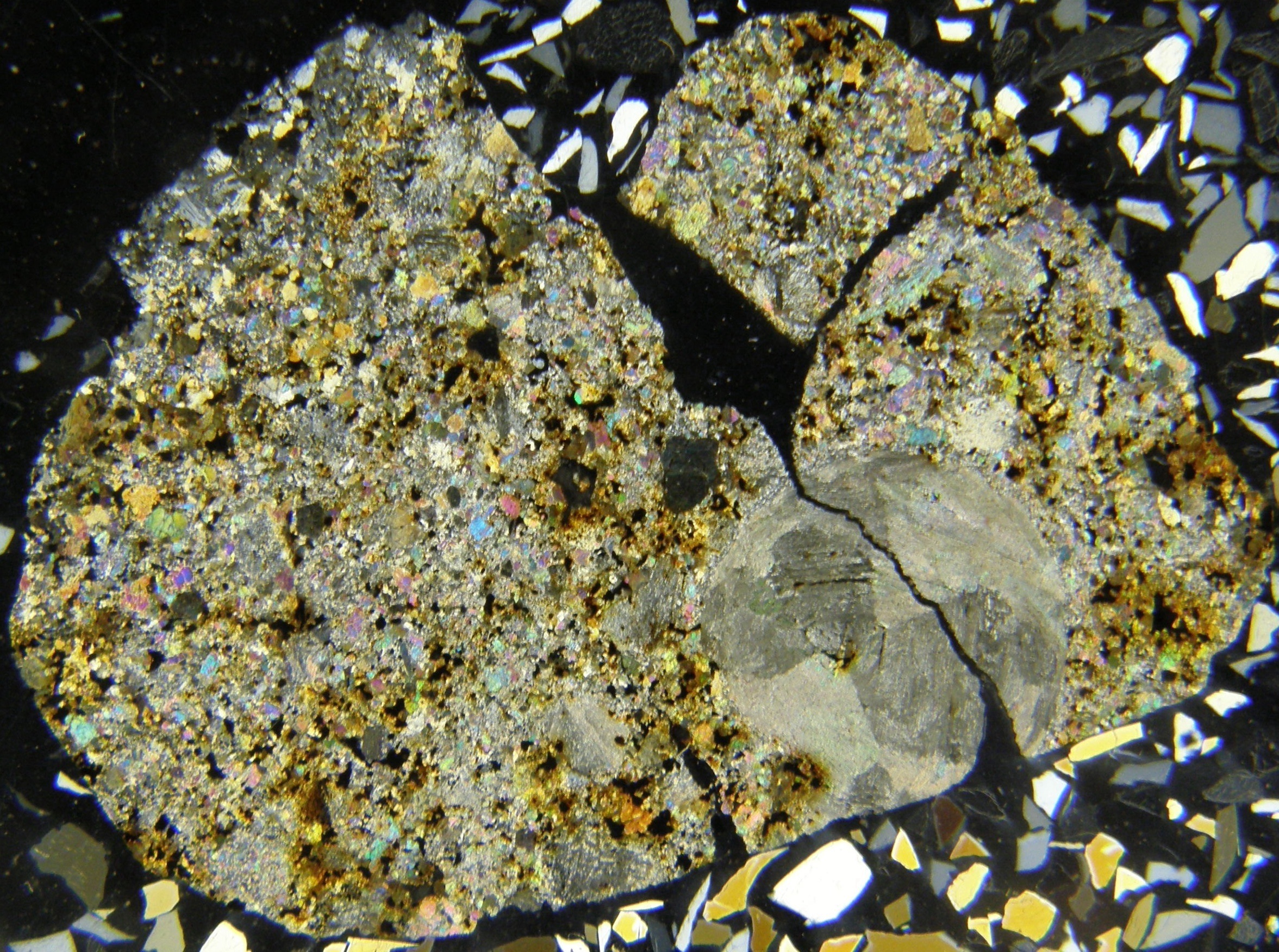 28.4g overview cross polars (XN) |
Thin Section Images
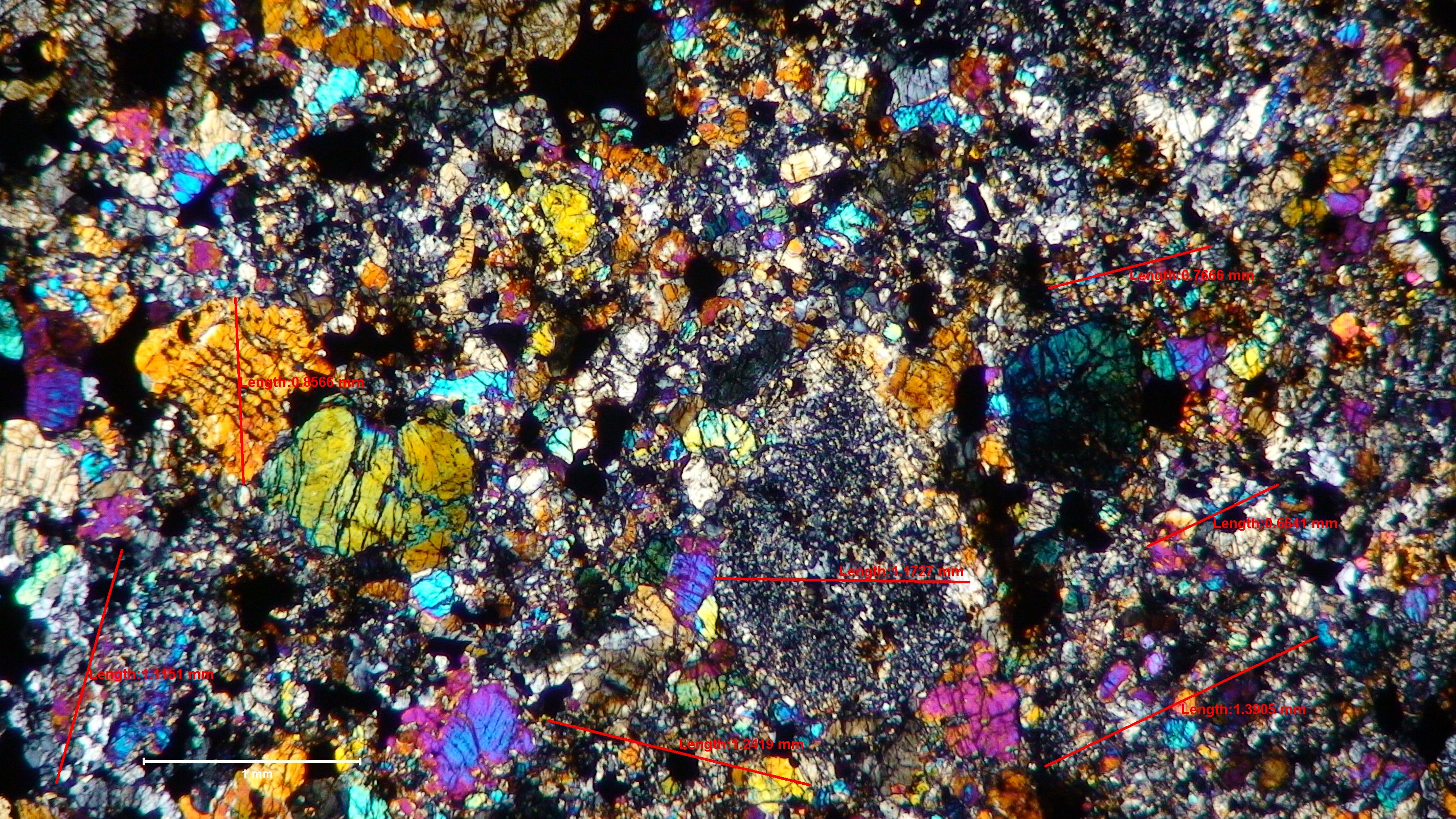 detail overview of relict chondrules and fragments (w/measurements) in XN (scale = 1mm @ 25x) |
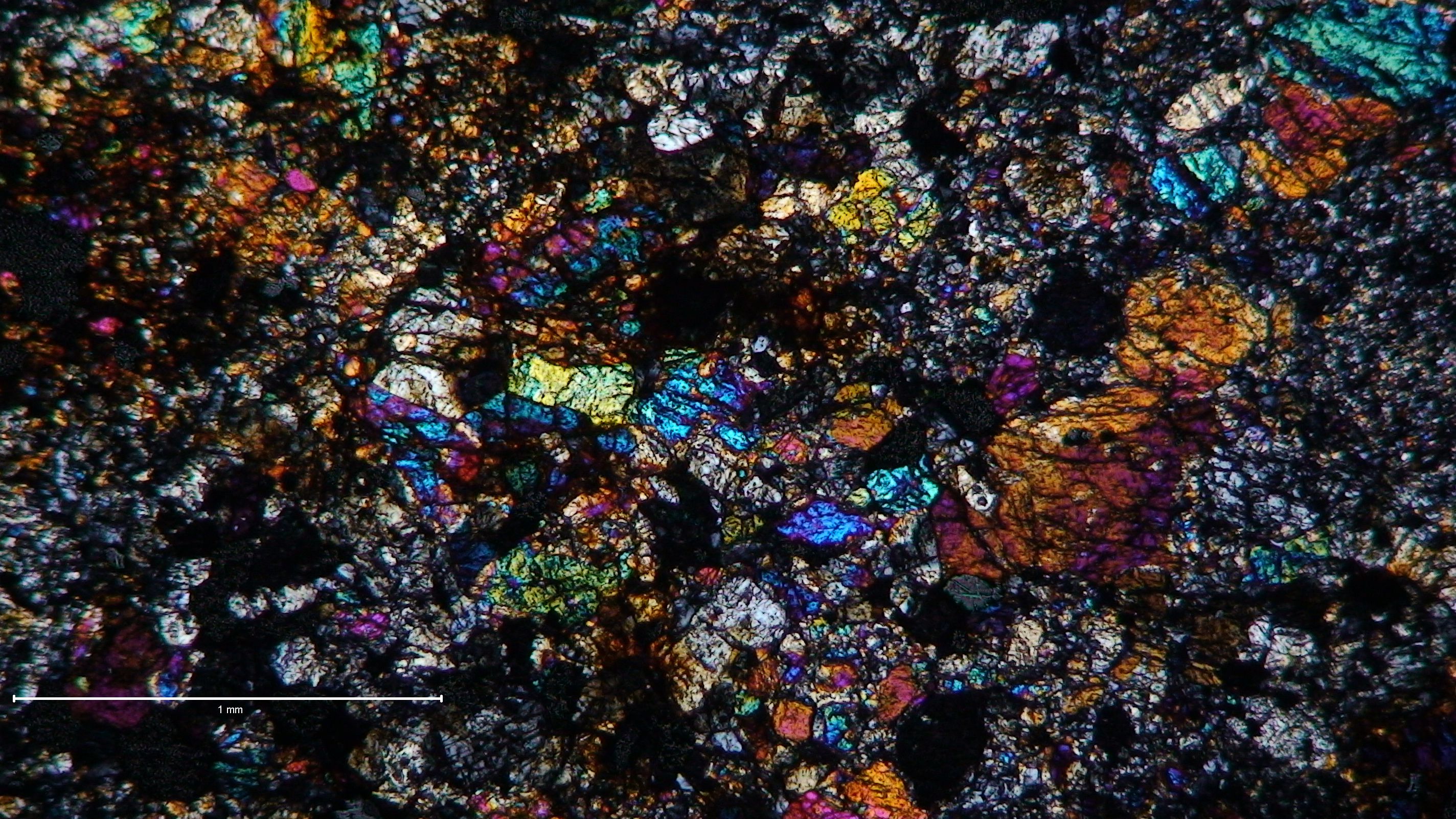 detail of relict olivine pyroxene chondrule in XN � (scale = 1mm @ 50x) |
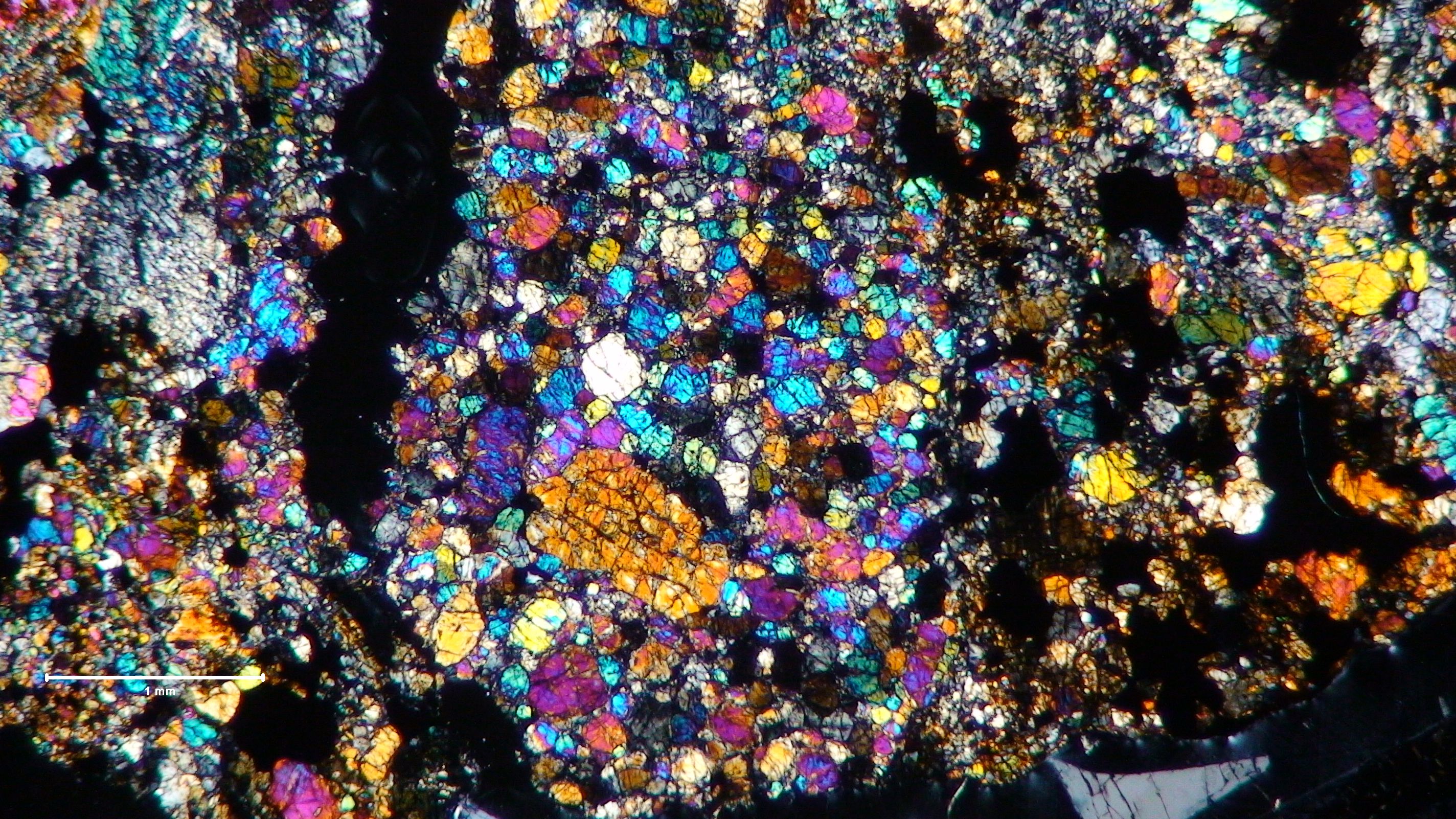 detail of a large granular olivine chondrule in XN (scale = 1mm @ 25x) |
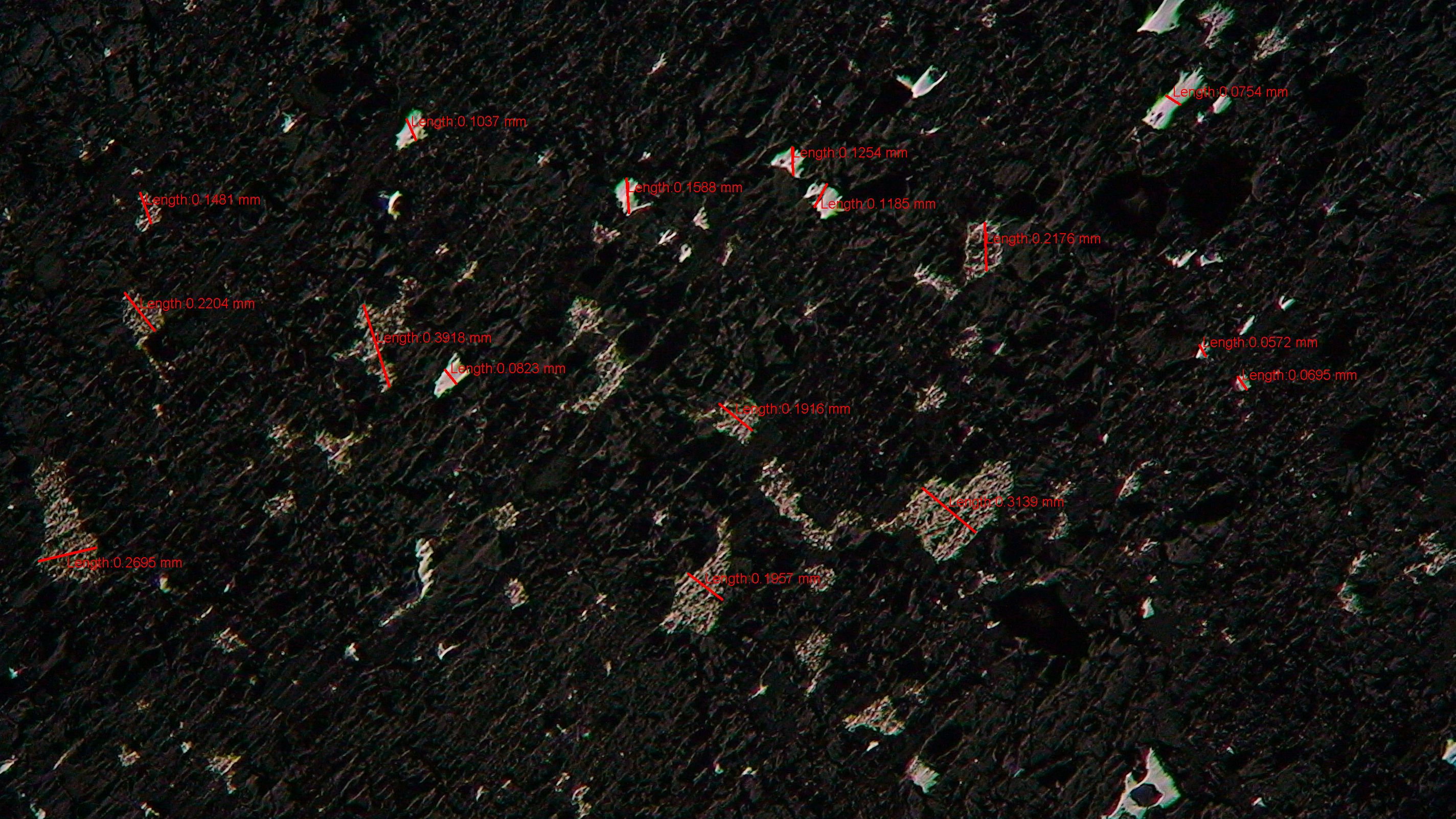 detail of FeNi metal (silver) and sulfide grains (bronze) in relected light |
NWA (GC_2) may be NWA 869?? 6g L4-6br S2 W1
Dark brown weathered fragment (minor fusion crust?)
Petrography:
Chondritic brecciated texture with multiple euhedral chondrules and chondrule fragments. 4 clasts of recrystallized dissimilar petrologic type indentified within matrix.
Lithology 1 Type 1 & 2 chondrules set in translucent matrix (see Figure 1). Multiple chondrule fragments, low metal. ~2% (avg. grainsize -..331mm)FeNi, ~1%(avg. grainsize -.220mm) FeS
Chondrules show porphyritic and barred chondrule texture. Mean chondrule size - .
Lithology 2 few relict chondrules set in recrystallized matrix, low metal. ~2% (avg. grainsize -.118mm)FeNi, <1% FeS
Chondrules show porphyritic and barred chondrule texture. Mean chondrule size NA
Geochemistry: Lithology 1 Fa 24, Fs 20; Lithology 2 Fa 24 Fs 19
Secondary Features(metamorphism):
Lithology 1 Porphyritic chondrules contain turbid glass and glass containing micrcrystalline plagioclase, Clinoenstatite present <20%
Lithology 2 matrix and chondrules highly recrystallized. One barred olivine chondrule fragment present. Orthopyroxene dominant
Tertiary Features(shock effects): Lith 1&2 All grains exhibit undulatory extinction. Olivines and pyroxenes show planar fractures. Shock veins absent.
Weathering: FeNi show minor oxidation on outer-most rim of grains
Overview
6g overview in PL |
6g overview in XN |
Thins Section Images
detail showing lithologys 1&2 (clear xstln area in lower right) with chondrule measurements in PL (scale = 1mm @ 25x) |
6g spec. Overview in XN (scale = 1mm @ 25x) |
detail of rimmed porphyritic olivine chondrule in XN (scale = 1mm @ 50x) |
detail showing lithology 2 in PL (scale = 1mm @ 50x) |
detail showing lithology 2 in XN (scale = 1mm @ 50x) |
detail showing intrachondrule mesostasis with secondary feldspars developing in PL (scale = 1mm @ 200x) |
detail showing chondrule with glassy mesostasis in PL (scale = 1mm @ 50x)
|
NWA (GC_3) 24g L5 S3 W2 (unpublished data)
Light brown weathered fragment. No fusion crust visible.
Petrography:
Relict chondritic texture with few subhedral chondrules. Surviving chodrules show porphyritic and barred chondrule texture. Mean chondrule size .96mm.
Chondrules: Type IB & IIA chondrules set in recrystallized matrix. Avg. Chondrule diameter 1.8676mm). Multiple barred olivine chondrules and chondrule fragments Metal: low metal. (~10%): -3%FeNi (avg. grainsize .098mm); -7% FeS (avg. grainsize .24mm)
Geochemistry: Fa 25, Fs 21
Secondary Features(metamorphism): Total absence of primary glass in porphyritic chondrules, very low abundance of clinoenstatite (<1%)
Tertiary Features(shock effects): All grains exhibit undulatory
extinction. Olivines and pyroxenes show planar fractures. Pyroxenes show weak
mosiacism. Minor shock veins present, but not extensive.
Weathering: FeNi show minor oxidation (.15mm) on outer-most rim of grains
Overview
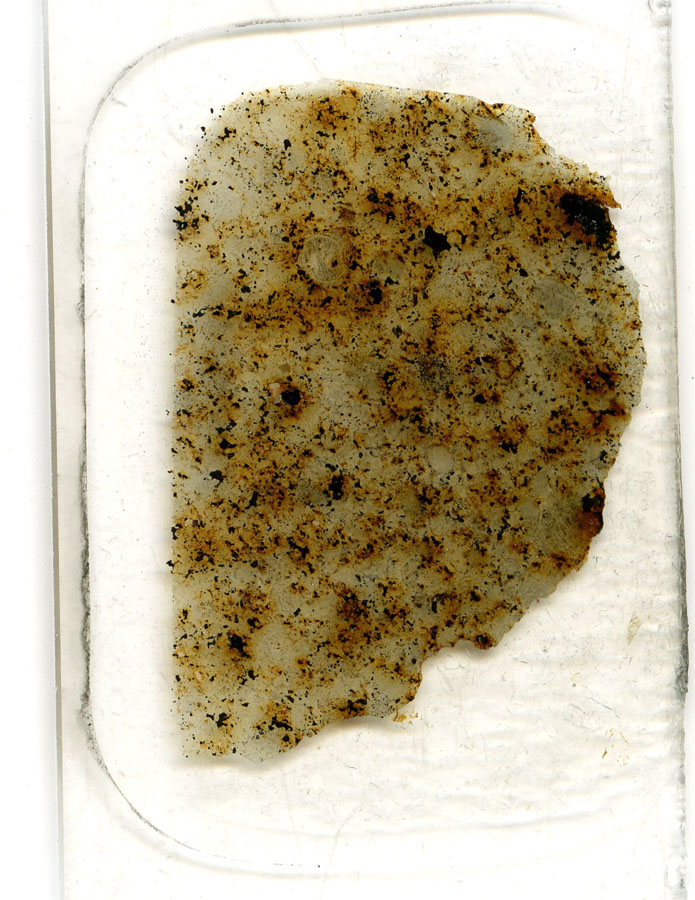 Fig. 1 Overview photo in plain light (PL) (long dimension of slide is 47mm) |
Fig. 2 Chemical analysis map |
Image Gallery
Fig. 3 Plot of Fayalite # Vs. Ferrosillite #. Note position of red “x” (falls within L-compositional group) which denotes composition of GC_24. |
Fig. 4 detail overview of relict chondrules (barred olivine occurs near center of field of view) and fragments (w/measurements) in XN (scale = 1mm @ 25x) |
Fig. 5 Detail showing backscattered electron image of barred olivine chondrule (scale = 1mm @ 50x) |
Fig. 6 detail overview of relict chondrules (barred olivine chondrules adjacent to one another occur near center of field of view) and fragments (w/measurements) in XN (scale = 1mm @ 25x) |
Fig. 7 detail overview of relict chondrules (large barred olivine occurs near center of field of view) and fragments (w/measurements) in XN (scale = 1mm @ 25x)
|
Fig. 8 detail showing weak mosaicism in Pyroxene grain within matrix (pyroxene is dark-gray left of center of field of view) in XN (scale = 1mm @ 50x)
|
Fig. 9 detail of matrix showing FeO staining around metallic FeNi grains in PL (scale = 1mm @ 25x) |
Fig. 10 Detailed overview of metallic phases including minor shock veins within chondrule (FeNi 0- silver, FeS – bronze, FeO – gray) |
NWA (GC_4) 2.6g EL 3/4 S1 W4 (likely paired with NWA 2828 and NWA 2965) (unpublished data)
Gray-brown weathered fragment. No fusion crust visible.
Petrography:
Cryptic chondritic texture with few subhedral chondrules set in recrystallized matrix. Few surviving chodrules show porphyritic and radial pyroxene texture.
Chondrules: Type IB chondrules set in recrystallized matrix. Avg. Chondrule diameter 0.4mm).
Matrix consists of prismatic enstatite crystals (Avg. Grainsize .0392mm).
Metal: low metal. (<1%): 0% FeNi (avg. grainsize .23mm) all FeNi Metal oxidized to geothite; <1% FeS with daubreelite (avg. grainsize .25mm) Sulfide oxidized to Geothite and FeSO4 (Gypsum)
Geochemistry: Orthpyroxene: En 98 Fs .49 Wo 1.5
Secondary Features(metamorphism): No glass recognized in surviving relict chondrules, No clinoenstatite
Tertiary Features(shock effects): All grains normal extinction.
Pyroxenes show planar fractures.
Weathering: FeNi and FeS show complete oxidation (.15mm) on all grains. Daubreelite lamellae preserved within some sulfides.
Overview
Fig. 1 Overview in plain light (PL). Long dimension of specimen is 2 cm. |
Fig 2. Overview in XP. Long dimension of specimen is 2 cm. Specimen is slightly thick as exhibited by interference colors of surrounding quartz. |
Thin Section Images
Fig. 3 Detail showing relict porphyritic pyroxene chondrule in XP. (scale = 0.5mm @ 100x) |
Fig. 4 Detail showing relict porphyritic pyroxene chondrule in PL (scale = 1mm @ 50x) |
Fig. 5 Detail showing oxidized FeNi grain in contact with oxidized FeS grain (containing subparallel lamellae of daubreelite) in PL (with reflected light). (scale = 0.5mm @ 200x) |
Fig. 6 Detail showing mean grain size of pyroxene matrix in XP (scale = 0.5mm @ 200x) |
NWA 5799 LL4 S3 W2 Data Published in Meteoritical Bulletin No. 96, July 2009
Specimen preparation performed at Appalachian State University, Boone, NC, USA by Anthony Love. One polished thin section was produced for optical and electron microscopy. Mineral composition and gechemical analyses were perfromed on athe FEI Quanta 200 Environmental Scanning Electron Microscope with EDAX EDS detector. Chemical analyses performed at 25.00 KV usig 5 µm spot size for 50 minutes. Four analyses were averaged for each mineral grain analyzed. Mineral analyses were calibrated using Smithsonian Institution mineral standard for Omphacite. Olivines and Pyroxenes were analyzed for Si, Mg, Fe, Al, K, Ca,, Na, Ti, Mn. Oxide analyses were performed and then normalized to elemental analyses. Fa and Fs #'s were calculated from elemental analyses.
A 497g partially crusted stone meteorite was found in 2008 and purchased in Dahkla Agadir, Morrocco in early 2009. Greg Catterton aquired the sample in early 2009 from a meteorite prospector.
Macroscopic Description: Stone appears to be oriented and fusion crust is blackish-dark brown in color and appears intact. Fusion crust covers 60% on stone. Fusion crusted side shows flat faces seperated 120º angles. No flowlines, rollover lipping or regmaglypts visible in fusion crust. No chondrules visible through fusion crusted surface. Chondrules visible on uncrusted side of sample. Sample contains no marks that indicate direction or depth of burial. Sample exhibits weak attraction to magnet.
Interior of sample shows abundant dark colored chondrules set in in a light yellowish brown fine-crystalline matrix. Some chondrules show fine white rims surrounding darker chondrule interior. Obvious brecciation is not apparant. No metallic shock veins visible on sample surface. Sample contains distinct areas of oxidation localized around some FeS-rich areas.
Exterior and interior photos of Sample ASU-NWA-5
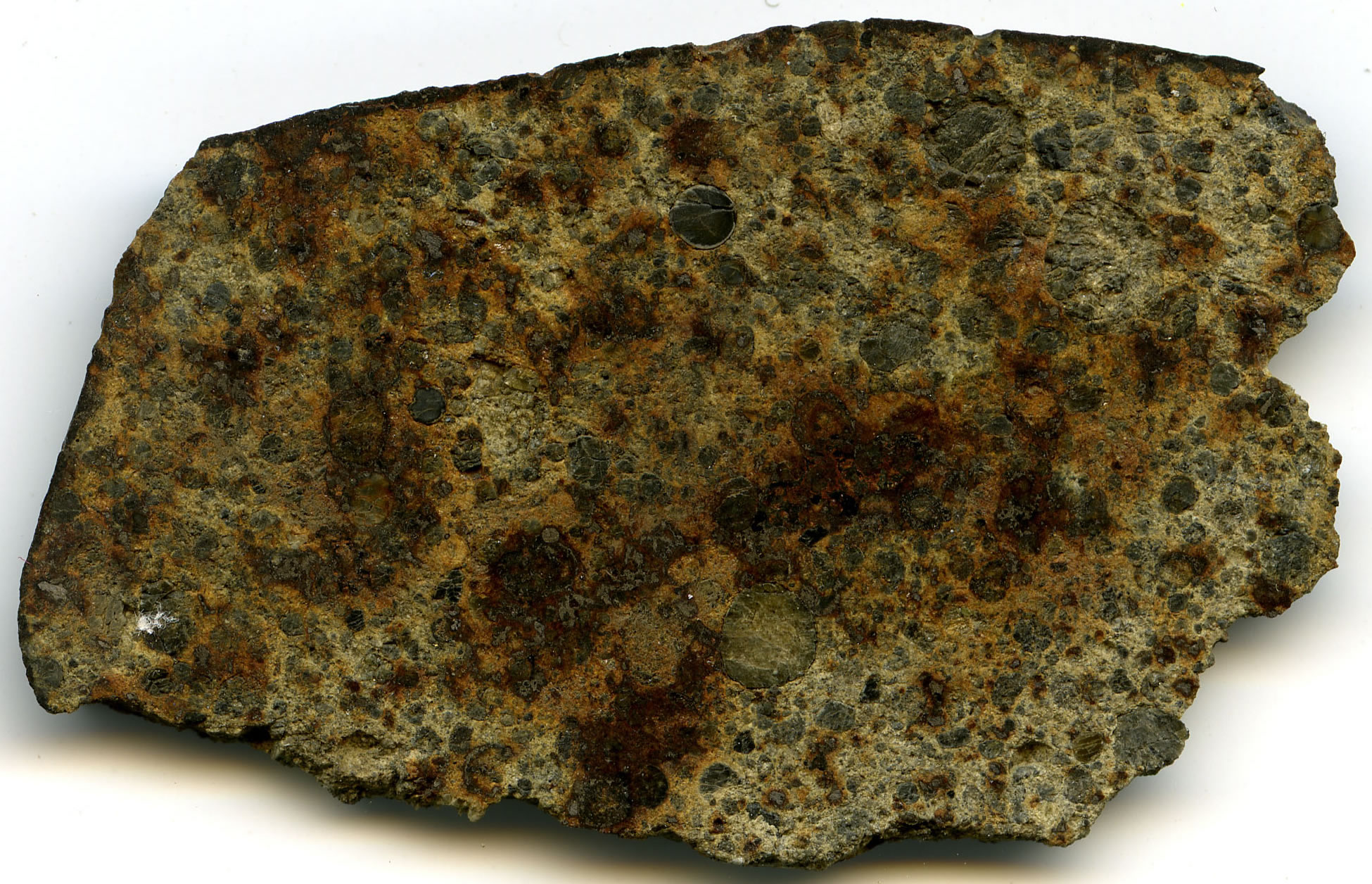 |
Description and classification (Anthony Love, Appalachian State University): monomict chondritic breccia containing abundant well-formed chondrules set in fine-grained matrix.
Chondrules: Sample contains: type IIA, IIAB porphyritic chondrules with devitrified mesostasis and dusty FeS rich rims; type IIA barred olivine chondrules; type IIB radial pyroxene chondrules, some of which contain bleached rims. Chondrules range in diameter from .14 - 2.2mm (mean=1.17mm).
Matrix: Contains fine-grained mixtrue of olivine, ortho/clinopyroxene, kamacite, taeniteand abundant troilite.
Secondary Processing
Aqueous Processing: Sample contains numerous radial pyroxene chondrules with bleached rims,
Thermal effects: Olivine (mean % dev. = .48) and pyroxene (mean % dev. = .41) compositions are <5% different from one another. Sample contains ~40% clinoenstatite
Shock effects: No shock veining observed. Most olivines exhibit weak undulatory extinction. Many olivines and pyroxenes contain planar fractures. Mosaicism not observed.
Weathering: Sample contains light weathering. Minor oxide rims occur on FeNi grains and minor oxide veins occur within some chondrules. Troilite exhibits more extensive weathering than FeNi. Weathering of troilite along parting planes shows development of pentlandite. Sample contains localized patches of oxidized chondrules and matrix where sulfides are present in chondrule rims.
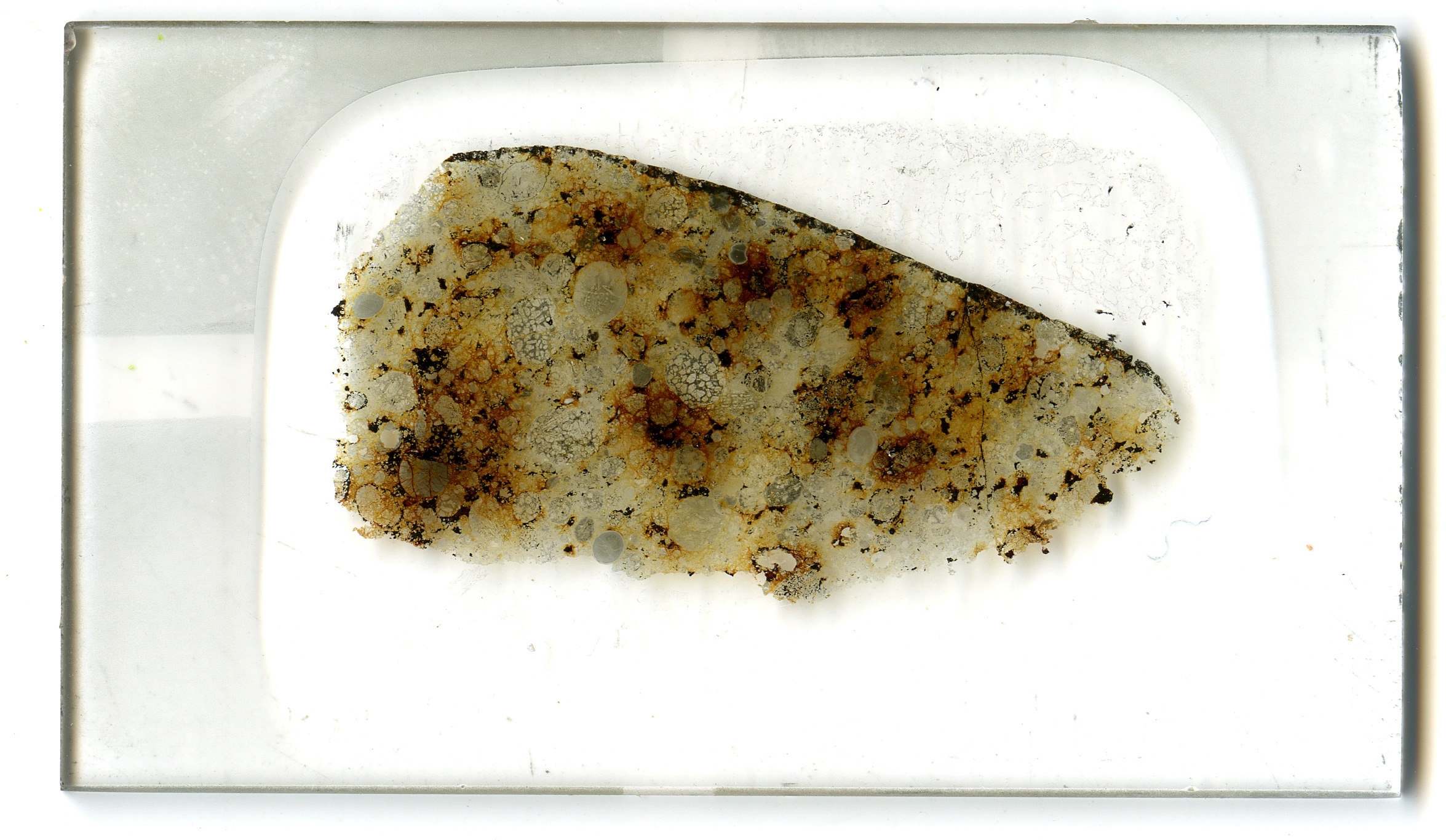 |
|||
.1.jpg) |
.2.jpg) |
.3.jpg) |
.4.jpg) |
Mineral Compositions and Geochemistry
.png)
Olivines: Fa 28.19 +/- .4
Pyroxenes: Fs 23.23 +/- .4
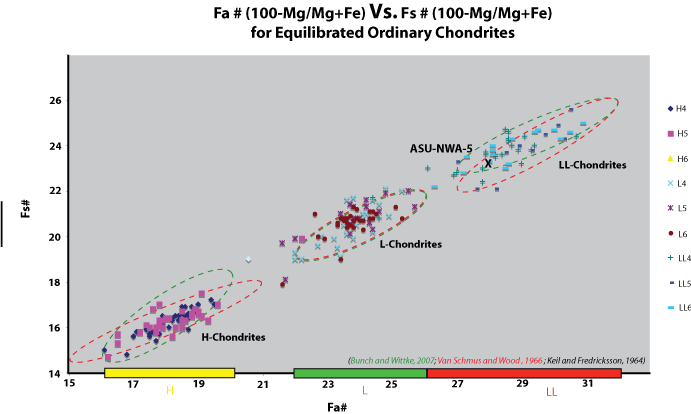
Classification: NWA 5799 LL4 S3 W2
Type Specimen 2-8 gram slices and one thin section on deposit at ASU Dept. of Geology. Main mass with owner, Greg Catterton
Links |